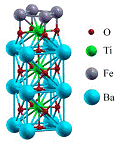Department of Physics and Astronomy: Publications and Other Research
Date of this Version
3-20-2018
Citation
PHYSICAL REVIEW B 97, 094107 (2018).
DOI: 10.1103/PhysRevB.97.094107
Abstract
In a ferroelectric field effect transistor (FeFET), it is generally assumed that the ferroelectric gate plays a purely electrostatic role. Recently it has been shown that in some cases, which could be called “active FeFETs,” electronic states in the ferroelectric contribute to the device conductance as the result of a modulation doping effect in which carriers are transferred from the channel into the ferroelectric layers near the interface. Here we report first-principles calculations and model analysis to elucidate the various aspects of this mechanism and to provide guidance in materials choices and interface termination for optimizing the on-off ratio, using BaTiO3/n-SrTiO3 (electron-doped SrTiO3) and PbTiO3/n-SrTiO3 as prototypical systems. It is shown that the modulation doping is substantial in both cases, and that the electrostatic model developed in previous work can be used to predict electron transfer. This model can thus be used to suggest additional materials heterostructures for the design of active FeFETs.


Comments
Copyright 2018 American Physical Society. Used by permission.